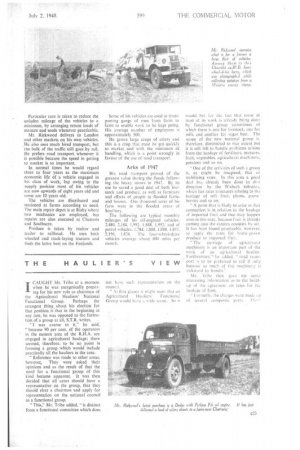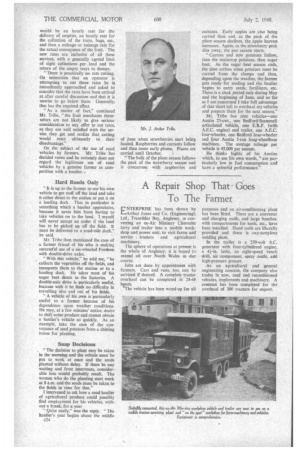THE HAULIER'S VIEW I CAUGHT Mr. Tribe at a moment when
Page 65

Page 66

If you've noticed an error in this article please click here to report it so we can fix it.
he was energetically preparing for his new role as chairman of the Agricultural Hauliers' National Functional Group.. Perhaps the strangest thing. about his election for that position is that in the beginning at any rate, he was opposed to the formation of a group at all S.T.R. writes.
"1 was averse to it," he said, " because 90 per cent. of the operators in the eastern area of the R.H.A. are engaged in agricultural haulage; there seemed, therefore, to be no point in forming a group which would include practically all the hauliers in the area.
" Reference was made to other areas, however, They were asked their opinions and as the result of that the need for a functional group of this kind became apparent. It was then decided that all areas should have a representative on the group, that they should elect a chairman and apply for representation on the national council as a functional group.
"This," Mr. Tribe added, "is distinct from a functional committee which does not have such representation on the council.
" At first glance it might seem that an
Agricultural Hauliers' Functional Group would have a wide scope. Sr it
would but for the fact that some at least of its work is already being done by functional group committees of which there is one for livestock, one for milk and another for sugar beet. The scope of the new national group is. therefore, diminished to that extent but it is still left to handle problems arising from the haulage of fertilisers, manures, fruit, vegetables, agricultural machinery, potatoes and so on.
One of the activities of such a group is, as might be imagined, that of stabilizing rates. In this area a good deal has already been done in that direction by the Wisbech sub-area, which has rates structures relating to the haulage of soft fruit, plums, gooseberries and so on.
" A point that is likely to arise in that connection is in relation to the haulage jf imported fruit and that may happen even in this area, because fruit is already coming into the eastern counties by air. It has been found practicable, however. to apply the rates for home-grown produce to imported fruit.
" The carriage of agriculture I machinery is an important part of the work of an agricultural haulier. Furthermore," lie added. " road transport is to be preferred to rail if only because so much of this machinery is awkward to handle."
Mr. Tribe then gave me sonic interesting information as to the buildup of the agreement on rates for the haulage of fruit.
" Formerly, the charges were made up of several composite parts. -1 cr
would be an hourly rate for the delivery of empties, an hourly rate for the collection of the trays, bags, etc., and then a mileage or tonnage rate for the actual conveyance of the fruit. The new rates are inclusive of all these services, with a generally agreed limit of eight collections per .load and the return of the empty trays to dumps.
"There is practically no rate cutting. On intimation that an operator is attempting to cut these rates he is immediately approached and asked to consider that the rates have been arrived at after careful discussion and that it is unwise to go below them. Generally, that has the required effect.
"As a matter of fact," continued Mr. Tribe, " the fruit merchants themselves are not likely to give serious consideration to any offer to cut rates, as they are well satisfied with the service they get and realize that cutting would react ultimately to their disadvantage."
On the subject of the use of road vehicles by farmers. Mr. Tribe has decided views .and he certainly does not regard the legitimate use of road vehicles by a genuine farmer as competition with a haulier..
Hard Roads Only " It is up to the farmer to use his own vehicle to get stuff off the land and take it either direct to the station or put it on a loading dock. That in particular is something which a haulier appreciates, because it saves him from having to take vehicles on to the land. I myself will never accept an order if the load has to be picked up off the field. It must be delivered to a road-side dock," he said.
Mr. Tribe then mentioned the case of a farmer friend of his who is making .successful use of a six-wheeled Fordson with double-drive axles.
With this vehicle," he told me, "Ile collects the vegetables off the fields, and transports them to the station or to a loading dock. He takes most of his sugar beet direct to the factories. A double-axle .drive is particularly useful, because with it he finds no difficulty in travelling into and out of his fields.
"A vehicle of his own is particularly useful to a farmer because of his dependence upon weather conditions. He may, at a few minutes' notice, desire to shift some produce and cannot obtain a haulier's vehicle so quickly. As an example, take the case of the conveyance of seed potatoes from a chitting house for planting.
Snap Decisions of June when strawberries start being hauled. Raspberries and currants follow and then come early plums. Plums are carried until October.
"The bulk of the plum season follows the peak of the strawberry season and is concurrent with raspberries and currants. Early apples are also being carried then and, as the peak of the plum season declines, the apple harvest increases. Again, as the strawberry peak dies away, the pea season starts.
"Carrots and new potatoes follow, then the rnaincrop potatoes, then sugar beet. As the sugar beet season ends, the time arrives when potatoes must be carried from the clamps and then, depending upon the weather, the farmer gets ready for seeding and the haulier begins to carry seeds, fertilizers, etc. There is a slack period only during May and the beginning of June, and so far as I am concerned I take full advantage of that short lull to overhaul my vehicles and prepare them for the next season."
Mr. Tribe has nine vehicles—one Austin 25-cwt., one Bedford-Scammell articulated vehicle, one E.R.F. (with A.E.C. engine) and trailer, one A.E.C. four-wheeler, one Bedford four-wheeler and four Austin 5-ton long-wheelbase machines. The average mileage per vehicle is 45,000 per annum.
He thinks highly of his Austins which, to use his own words, "are particularly low in fuel consumption and have a splendid performance."












































































































